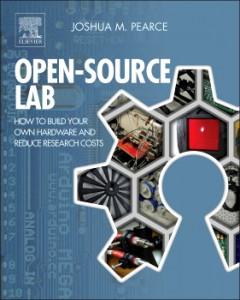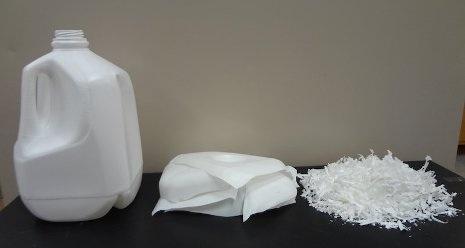 According to a new study produced by the Pearce Research Group at Michigan Technological University (MTU) you can now save yourself money and help the environment, all while making sure you have strong bones. It turns out that the plastic milk jugs used in many countries are actually more efficiently recycled into filament for 3D printers than into plastic for reuse. When the High Density Polyethylene (HDP) milk containers are recycled in traditional facilities, the energy consumed to make the material reusable is considerably greater than that which is consumed when they are processed to make filament in the comfort of your own home.
According to a new study produced by the Pearce Research Group at Michigan Technological University (MTU) you can now save yourself money and help the environment, all while making sure you have strong bones. It turns out that the plastic milk jugs used in many countries are actually more efficiently recycled into filament for 3D printers than into plastic for reuse. When the High Density Polyethylene (HDP) milk containers are recycled in traditional facilities, the energy consumed to make the material reusable is considerably greater than that which is consumed when they are processed to make filament in the comfort of your own home.
Part of the energy savings comes from lowering what is known as the embodied energy of the process. This means the resources that are put into the recycling process that aren’t necessarily included in just the moments when the recycling is occurring, in this case during sorting and transportation of the material. By recycling the milk jugs in your home, you eliminate transportation costs and greatly reduce the energy expended on sorting (as you can now just have an extra bin for the containers).
 While in large metropolitan areas recycling systems are often integrated with collection and/or production systems and are therefore highly efficient, in smaller towns, such as the researcher’s hometown of Houghton, and rural areas, energy expenditures are much higher. In those types of situations an energy savings of nearly 80% can be realized through home recycling. The research team calculated that if the home recycling process detailed in their report were to be adopted across the country, it would result in annual energy consumption reduction of 100 million MJ.
While in large metropolitan areas recycling systems are often integrated with collection and/or production systems and are therefore highly efficient, in smaller towns, such as the researcher’s hometown of Houghton, and rural areas, energy expenditures are much higher. In those types of situations an energy savings of nearly 80% can be realized through home recycling. The research team calculated that if the home recycling process detailed in their report were to be adopted across the country, it would result in annual energy consumption reduction of 100 million MJ.
What makes this particularly enticing is the long term cost savings, especially if you are a regular purchaser of filament. While commercially available filament can cost anywhere between $36 and $50 a kilo, the recycled plastic filament can be produced for approximately 10 cents per kilo. This represents a discount of over 99.7%. HDPE plastic isn’t perfect, there is some shrinkage as the plastic cools but for making small objects at a local scale, the impact is negligible.
So what is involved, in becoming your own recycling center / filament producer?
The first step is to drink milk for strong bones…or, at least, to collect the jugs that the milk came in and to give them a good cleaning. The jugs can then be opened, flattened, and run through an office shredder. After shredding, the material becomes the feedstock for a post-consumer waste plastic extruder, such as the RecycleBot, also developed by Dr. Pearce. To continue the open-source and self-directed nature of the process, the team from MTU recommends printing the filament using a RepRap self-replicating rapid prototyper.
While often it seems as though the discourse surrounding sustainability is one that advocates giving up high tech and using only natural materials, it’s nearly impossible to imagine that technological advances will be voluntarily ‘un-learned.’ This study in materials science makes it clear that doing so is not the only way to think about the problems of production and consumption. The home recycling process discussed in the article published by the research team in the Journal of Cleaner Production is just one part of a larger group of initiatives such as the Ethical Filament Foundation’s program to help trash collectors in developing countries turn the plastics they find into filament they can sell.
You don’t have to give up high tech to contribute to a healthier, cleaner world. In fact, Dr. Pearce notes, “3D printing can…potentially change the water shortage in developing countries and solve the food crisis in many areas.”
Now all you need is a superhero costume. Let us know your opinion of this story in the Milk Container to 3D printer filament forum thread on 3DPB.com.
Subscribe to Our Email Newsletter
Stay up-to-date on all the latest news from the 3D printing industry and receive information and offers from third party vendors.
You May Also Like
3DPOD Episode 198: High Speed Sintering with Neil Hopkinson, VP of AM at Stratasys
Neil Hopkinson, a pioneering 3D printing researcher, played a pivotal role in developing a body of research that is widely utilized today. He also invented High Speed Sintering (HSS), also...
GE Additive Transforms into Colibrium Additive in New Brand Move
One of the largest and most compelling companies in the 3D printing industry, GE Additive, has undergone a rebrand. Now, known as Colibrium Additive, the company and its new name...
HP & INDO-MIM Collaborate to Boost Metal 3D Printing in India
HP Inc. and INDO-MIM, a US- and India-based supplier of metal injection molding (MIM) powders and contract manufacturer, have announced that the two companies will collaborate to accelerate additive manufacturing...
Nylon 3D Printed Parts Made More Functional with Coatings & Colors
Parts 3D printed from polyamide (PA, Nylon) 12 using powder bed fusion (PBF) are a mainstay in the additive manufacturing (AM) industry. While post-finishing processes have improved the porosity of...

































